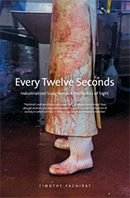Every Twelve Seconds: Industrialized Slaughter and the
Politics of Sight

Author: Timothy Pachirat
Publisher: New Haven, CT: Yale University Press, 2011. 320p.
Reviewer: Jarret S. Lovell | March 2013
It has been nearly fifteen years since an article appearing in the journal Criminology called for human-animal interaction to be incorporated into the mainstream of criminological inquiry (Beirne, 1999). Since then, the importance of animals within the discipline has certainly grown. Today, it is not hard to find publications exploring the link between animal abuse and criminal behavior, the illegal trafficking and poaching of wildlife, or the role of animals in prisoner therapy and rehabilitation. Even examinations of environmental crimes are now framed in a manner that incorporates animals as victims of pollution and deforestation. Yet when it comes to humans’ daily treatment of animals on factory farms for the purposes of food production, with few exceptions (e.g., Agnew, 1998) social scientists have shied away from the political, criminological and sociological implications of our treatment of animals at large industrial slaughterhouses.
In his insightful book, Every Twelve Seconds: Industrialized Slaughter and the Politics of Sight (2011; Yale University Press), Timothy Pachirat draws on his experience as an undercover worker in a slaughterhouse to describe the inner workings of a Midwestern factory farm – from the front office to the kill floor. In so doing, he becomes perhaps the first social scientist to address the literal and symbolic meaning of industrialized slaughter, singly pushing the boundaries of the criminological study of animals to regions where it ceased to tread – toward our everyday use of animals for food. What emerges from his study of meat production is a new understanding of politics and morality in civilized society. Moreover, this new framework becomes manifest through what is largely the author’s first-person narrative, allowing him to easily comment on an array of existing theories without miring the reader in too much jargon or losing focus on his intended subject: the production of meat and its relevance to our broader political culture.
On first glance, qualitative research examining the workings of a Midwestern slaughterhouse may seem an odd contribution to theory. Yet, Every Twelve Seconds is no mere update of Upton Sinclair’s The Jungle, nor is it simply an expose revealing the unseemly nature of meat production – although it does accomplish both. Instead, the book uses the slaughterhouse for a broader consideration of the dirty side of contemporary society. Specifically, Pachirat draws on Norbert Elias’s idea of “the civilizing process.” What we refer to as becoming civilized is really the deliberate concealment from public view of the more vulgar practices of society that most people would rather not have to think about, let alone see. Certainly, the daily practice of animal slaughter for the production of meat constitutes one such vulgar practice that is deliberately hidden from the mainstream of society. After all, who among us wants to witness the shooting of a piston into the skull of an animal, then its hoisting by its hind leg (often while the animal is still alive and sentient), its subsequent electrocution and gutting in the bleed pit until it next makes its way on the (dis)assembly line to the tail ripper, to the head severer, the gullet clearer, and so on?
What passes for moral progress and becoming more civilized then, is often “the distancing and concealment of morally and physically repugnant practices rather than their elimination or transformation” (p. 11). Consider this: Many readers are likely to be familiar with the adage that there would be more vegetarians if slaughterhouses had glass walls. Yet slaughterhouses have not been done away with; they have simply been concealed from the public, often with the protection of legislation. Indeed, in at least five states, the law criminalizes the unauthorized photographing of factory farms to ensure that the production of meat – in what are particularly cruel and gruesome manners – continues unabated and with little public outcry. Every Twelve Seconds makes good use of this “if slaughterhouses had glass walls” adage by applying the argument to other social institutions in order to address the roles that distance and concealment play in allowing the dirty work of civilization to continue. “Like its more self-evidently political analogues – the prison, the hospital, the nursing home, the psychiatric ward, the refugee camp, the detention center, the interrogation room, the execution chamber, the extermination camp” (p.40) – the slaughterhouse exists at its current level of operation (one slaughter every twelve seconds) not simply because of its acceptability, but perhaps in large part due to its invisibility.
It is here that Pachirat applies the lessons of the slaughterhouse more broadly by noting that invisibility – rendered through distance and concealment – buttresses political power. By deliberately isolating the morally questionable practices of our culture, and placing those in what Zygmunt Bauman referred to as zones of confinement, government and corporate practices which might otherwise cause concern are kept out of public view, thus allowing them to flourish. The primary objective of Every Twelve Seconds, therefore, is to engage in what Pachirat calls a “politics of sight” which he describes as an effort “to breach, literally or figuratively, zones of confinement, in order to bring about social and political transformation” (p.15). To that end, Pachirat did breach the zone of confinement within which factory farms operate, working undercover for months at an industrial slaughterhouse, taking on various positions from working as a liver hanger to a quality control worker stationed on the kill floor.
Much of what constitutes the narrative of Every Twelve Seconds is his detailed description of kill work: how the gruesome killing of sentient beings is streamlined, mechanized, and routinized to maximize efficiency; how the segregation of employees into one hundred twenty one different and distinct tasks is an attempt to conceal from workers the fact that what they are doing is in fact “killing.” How despite these attempts to mask the killing the realization exerts a psychological toll on some slaughterhouse employees. Throughout, Pachirat’s descriptions are unemotional and even clinical. Yet readers cannot help but see in his description of a slaughterhouse, language that could just as easily be used to describe an extermination camp. And when he writes that the function of the farm kill floor is to “erase individuality,” to homogenize, to make “one thing identical to the thing next to it, which is identical to the thousands of things next to it” (p.40), readers must remind themselves that the descriptions are those of the tasks of emotionally detached workers on a factory farm; they are not the descriptions of intake officers at a maximum security prison, or of an officer at a secret overseas interrogation camp used by the military in the war on terror.
It is these parallels between slaughterhouses and other secreted social institutions that make Every Twelve Seconds such a powerful contribution to the study of political power in contemporary society. With the death penalty completely removed from public view, with the use of drones in modern warfare which completely detaches the soldier from the theater of war, an examination of the role of distance and concealment in the execution of political power has never been more prescient. Of course, this cognitive distance and emotional detachment are modern political necessities that allow for the performance of dirty work. So too is the public’s isolation from the cruelty of industrial slaughterhouses that perform the dirty work which feeds what we casually refer to as our “civilized” society.
References
Agnew, R. (1998). “The Causes of Animal Abuse: A Social-Psychological Analysis”, Theoretical Criminology, 2: 177-209.
Beirne, P. (1999). “For a Nonspeciesist Criminology: Animal Abuse as an Object of Study”, Criminology, 37 (1): 117-148.
Jarret S. Lovell, Ph.D., California State University, Fullerton


